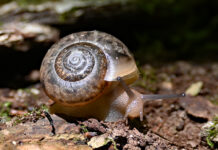I enjoy the company of most birds, but not European starlings. They are invasive, aggressive and noisy. And where there’s one, there’s a flock more often than not.
It’s not a good idea to let them eat at your feeders because they’ll want to hang around. It’s not a good idea to let them hang around because they’ll chase away other birds and want to move in. It’s not a good idea to let them take up residence in your nest boxes because they’re taking prime nesting sites away from native cavity nesters.
Starlings are bird bullies like pigeons, blue jays, grackles and blackbirds. They can be aggressive towards other birds and even people. And because they travel in flocks, once they settle in an area, they can deplete resources, such as food and nesting sites, that native birds rely on.
Starlings are such a nuisance that they are one of the only bird species that federal law allows the removal of their nests and eggs.
Killing them is one way to get rid of them, however, scientists believe eliminating potential nesting sites and implementing other exclusionary practices are probably better ways to impact their overall population long-term.
Getting rid of European Starlings
There are several ways to discourage starlings from visiting your backyard. Eliminating easy access to food sources and nesting sites is crucial. Implementing other deterrents can also help. Below are seven ways to get rid of starlings.
Choose foods they don’t enjoy. Starlings have long, pointy, soft beaks, which are suited to eating insects, spiders, snails, caterpillars, fruits, grains and small seeds. Some of their favorite foods include cracked corn; sunflower kernels and chips; suet with corn, peanuts or shelled seed inside; shelled peanuts, millet, mealworms and bread or other human food.
Starlings have trouble eating any food that has a thick outer shell because their slender beaks can’t crack the food open. Offering a seed mix composed of black-oil sunflower seed, striped sunflower seed, safflower, unshelled peanuts and nyjer will attract a lot of songbirds without attracting starlings.
Use bird feeders starlings can’t use. Starlings have trouble accessing birdseed in cage feeders, tube feeders without perches and weight-sensitive feeders. Additionally, they don’t enjoy feeding from suet feeders that only offer access from the bottom. They are reluctant to go under any sort of cover. Hanging a feeder under a domed squirrel baffle will also deter them.
Catch seeds. Placing containers under your hanging feeders to catch seeds dropped by other birds will help prevent starlings from feeding beneath them on the ground.
Discourage nesting. Starlings are cavity nesters that have adapted to suburban and urban living. They are known for building their nests around humans in the small openings and vents around their houses. Seal off any openings and install vent covers to prevent starlings from finding a nesting site.
Monitor nest boxes. If you have birdhouses or nest boxes in your backyard, you’ll have to monitor them regularly for starlings. As soon as you notice a starling nest or eggs, remove them. As an invasive species in North America, starlings are not protected by The Migratory Bird Treaty Act. Starlings return to the same nesting locations year after year, so it’s important to make sure they don’t get used to using your nest boxes or birdhouses.
Starlings are not able to fit into nest boxes with a hole less than 1.5 inches in diameter.
Hang mirrors in large nest boxes. Nest boxes for woodpeckers, wood ducks and owls often get taken over by starlings. Hanging a small mirror on the back wall of a larger nest box, facing the opening, will help scare starlings away without deterring other birds.
Install moving lights. If you’ve run out of options, flashing strobe lights or moving stage lights can deter starlings. I’ve received feedback that this cheap option works well: LED Mini Stage Light.











